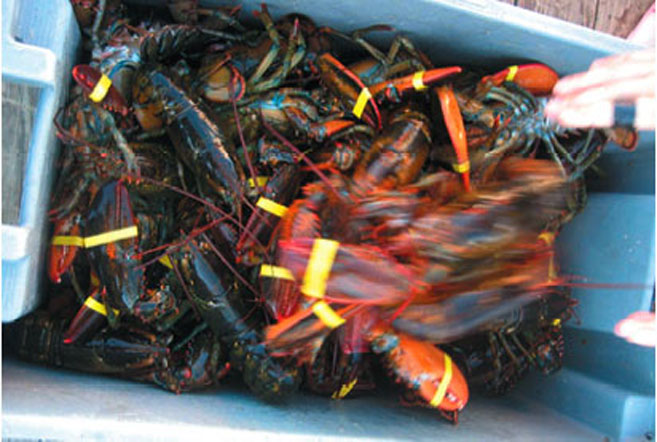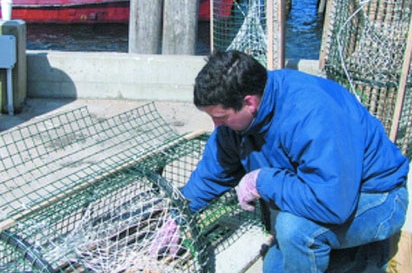Lobster Chronicles, Part IV
The wait is over! Lobster season in the waters around Cape Cod took off in the last week of June and the first weeks of July. Since October of last year I’ve investigated and reported on the status quo of the lobster scene from Sandwich to Provincetown, covering the history of lobstering in the Northeast, the rising and ebbing of the lobster industry and the general division of fisheries in the waters around Cape Cod. I introduced two lobstermen, Rob Martin, who fishes out of Cape Cod Bay, and David Young, who fishes out of Provincetown. In the spring, I talked about readying trap and the detailed work of lobstermen in the winter and spring as they prepare for the lobsters to migrate back to shore around mid-June. Last
issue, I focused on the distribution of lobsters once they reach the dock. That leaves one gap in the trail from lobster in the sea to lobster in my belly—the action on the boat, when there’s lobster aplenty.
From one boat to the next the day-to-day activity is much the same. Within each area, based on territorial hierarchy, the lobstermen set their traps in areas they believe will attract lobsters
based on bottom structure and thermoclines, depth and currents. For Rob Martin, the season kicked off a little sooner than for fishermen in the outer Cape Cod. He went from catching a hundred or so pounds a day to several hundred pounds by mid-July, but overall the total catch and impact has been down over past years. Rob goes out alone; captain and deck mate all in one. When he reaches a string of traps marked by his buoy colors, he snags the buoy and drags the line up to a motorized whench, raising the traps up from the depths. One by one, he lifts each trap onto the deck and removes the plethora of sea life from starfish and barnacles, to finfish, crabs and, hopefully, lobsters, lots of them. The rectangular design of the trap essentially includes a head, a kitchen, a parlor and a vent. Lobsters and whatever, enter through the knitted head scavenging for a sack of bait resting in the “kitchen.” The knitted head makes it difficult to back up, so once they enter and reach the bait, they are essentially trapped in a knitted “parlor.” The vent is designed to allow any small lobsters and sea critters a method of escape. Once on deck, the lobsters are sorted by Rob. Any lobster whose carapace—the length from the eye socket to the rear of the body shell—is over 3-1/4’’ is a keeper, unless it is an obviously egging female. Aside from regulating the number of traps in the water and licenses issued, maintaining a healthy population of young females prevails as the primary regulation measure in the lobster fisheries. Any females with eggs present cannot be harvested; any small egger caught in the trap must be marked by the lobsterman, who will carve a small “V” into the tip of the tail. It will take a series of four or more molts over a couple
of years for the notch to disappear. Even without the presence of eggs, any V-notched female must be thrown back. The number of eggers can account for anywhere from 10 percent to 30 percent of the lobsters caught. In shallower depths and closer to the shore where females spend the majority of their summer months in more protective waters, that ratio is even higher.
All keepers in the trap are affixed with claw bands and thrown into an onboard saltwater holding tank. Various forms of bait from skate and herring to odds and ends are refilled into the “kitchen” bag, and Rob continues through his trawl of pots, removing and refilling. Depending on the day, and the population of lobsters in a given area, he will haul anywhere from 100 to 200 pots a day. Even though the presence of lobsters may be felt strongly in the area as a
whole, they tend to migrate from food source to food source.
Objectively, lobstermen try to predict those areas, but there is little rhyme or reason. Day in and day out, with various highs and lows, the lobsters should remain steady throughout the rest of the summer. There tends to be a bit of a lull in August and September in overall catch volume, as the lobsters remain closer to shore following pockets of food source. They’ve had several weeks to feed, molt, and mate. Fat and happy, their movement and scavenging is not as fierce. In the later months of fall, as the colder waters return, they will head back to deeper, more temperature-stable waters. This tends to be the most profitable time on the water. The proportion of hard shell lobsters versus molting new shells is higher and more valuable; and the percentage of egging females reduced.
For David and Rob Young, our lobstermen in Provincetown, their day-to-day activities are much the same. Whereas Rob Martin in Sandwich fishes solo, Dave and his brother each have their own boat and license. Alternating between them, they fish together in the Outer Cape Area. In the deeper waters around Race Point, regulations differ slightly with regard to licensing and keepers commensurate with the ecology of that area. The total number of traps in that area remains the same, so lobstermen trade amongst themselves. The elevated currents are not as conducive to hatching and are more treacherous for smaller lobsters. Therefore, the Outer Cape lobsters tend to be larger and the minimum size of the carapace
for a keeper is a bit longer. The vent is also larger, allowing more small lobsters to escape. In the Outer Cape area, the population of egging females is lower as they opt for shallower waters, so lobstermen there can keep females with a v-notch. This year, the lobsters hit late on the Outer Cape, Rob and Dave did not really start fishing until the end of July. As I mentioned
in the summer, the cost of diesel has deeply impacted the bottom line for fishermen and they are feeling the pinch. They hope the lobstering from that point on stays strong until January, when they start removing their trawls and prepare for next year’s cycle, take a deep
breath and reunite with their families for winter.
KEEPING AN EYE ON THE FISHERY
The primary regulatory agency overseeing the lobster industry is the Massachusetts Division of Marine Fisheries. It monitors both the lobster population with the help of various research institutes and the activities of the men and women at sea. At the end of each day, lobstermen fill out a catch report indicating where they went and how many pounds they caught. GPS machines on board each boat send out a signal so their movements can be recorded. Essentially, they ensure that everyone is fishing within his or her boundaries. For the thousands of boats among myriad fisheries, there are extraordinarily few Environmental Police Officers (EPOs) to keep an eye on the conduct of lobstermen at sea. They primarily perform spot checks making certain the lobsters are legal, not undersized and not eggers. Initial offenses receive fines, but habitual abusers can loose their license. On the Outer Cape, EPOs check the number of traps when they are out of the water in the winter. In
Cape Cod Bay, they make certain the traps are configured properly to protect whales during prime migrations.
Despite the regulations and spot checks, the lobster population remains in a slow decline. Rumbles of further trap allotment restrictions trouble lobstermen as they continue to experience a reduction in revenue. Bill Adler, Executive Director of the
Massachusetts Lobsterman Association (MLA) for 20 years and a lifelong lobster expert, has seen these types of declines in the past. The cause can be anything from over-fishing, toxins poured into the sea from our rivers and cities, global warming and disease. The industry on the whole in the Northeast is stable; fisheries in Canada and Maine reported elevated catches this year due to the early onset of warm waters. Therefore, the decline in the southern waters does suggest over-fishing and disease as the culprits. At the MLA, Bill and his staff work as the big brother intermediaries, protecting both the fisheries and the livelihood of the lobstermen. They see industry incentives and education as a method to promote cleaner fishing. To members, they send out a weekly price/catch report and newsletters with updated information. The reports indicate fishing levels across
the Northeast to help fishermen gauge the overall fishing viability in certain areas and the average price at the dock. The MLA also sponsored the new green lobster bands to help guide consumers towards Massachusetts caught lobsters, which are caught using practices that are not harmful to the whale population.
BRINGING THE PLAYERS TOGETHER
Aside from education and advocacy, the MLA along with a consortium of other state based lobster associations, including The Lobster Institute, the National Oceanic and Atmospheric Administration, other marine research foundations and lobstermen all along the coast, is participating in a multi-year, multi-faceted research project known as eMOLT (Environmental Monitors on Lobster Traps). Over the years, lobstermen have tried to determine the delicate balance of water temperature, salinity and particulates, depth and current that promotes movement in the lobster population. Some have attempted to track such details on their own, but to little avail. In the larval stage, before their shells have hardened, lobsters are extremely susceptible to disease and toxicity. Since 2001, researchers have affixed probes to thousands of traps, and free floating buoys to transmit real-time wireless readings of various measures at sea. Since 2006, their database storage includes over 1.8 million hourly records of temperature and 80,000 hourly records of salinity. Ul
timately, the goal is to use these data to develop any statistical relationships between these measures, the health and drift of the larvae population and the
migration habits of the herd. The data are still being analyzed, but the primary success of the project is the cooperation among researchers, industry regulators and lobstermen to achieve the level of data they now have.
For David Young and Rob Martin, the obstacles in the industry and out at sea make every year during a downswing a bit more challenging. But, they are diehard lifers. Uncertainty abounds in most professions; for David the rush of a trap filled with lobsters compares to little else. To date, the most he’s caught in one trap is 41 and he’s still hoping to top that. As a member of the MLA, Rob feels like he has a forum to participate in the evolution of the industry. He and his partner, Lori Caron, take advantage of every opportunity to vocalize the issues faced by the men at sea. “That is the hope for the future, efficiency and research at sea, and somebody watching out for the little guy,” commented Lori after a lobster association meeting in New Hampshire. The next time you sit down for that $35.00 splurge on a lobster meal at a restaurant on the Cape, think of the number of hands and players that figure into each savory morsel; the long days at sea, the care of transport for such a vulnerable species, and the chefs who add one final flare of creativity. Eat slowly; the system is fragile. Essentially, the engine of the industry rolls on, but indicators of a decline in the health of lobster fisheries in Massachusetts and further south have many concerned.
After 15 years of waiting tables through school and beyond, Chelsea Vivian now combines her experience with food and her passion for protecting the environment by exploring the connection between the Cape’s natural resources and the food we eat..sipping a little wine along the way!






